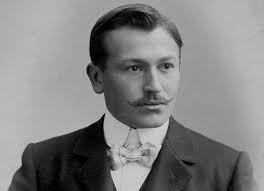Hans Wilsdorf was born in Kulmbach, Bavaria on March 22, 1881 and the second son to Protestant parents. The early death of his parents made him an orphan at the age of twelve. Although orphaned as a child, his grandfather’s prosperous business liquidated by his uncles helped him and his siblings become self-reliant and prepared for the future.
His grandparents might have been well-off but because of the early deaths of his parents, he never became extravagant or heedless. Consequently, his uncles believed that education was imperative to every man and so, they were placed in a boarding school to receive sound education. At an early age, he was fond of traveling and working in foreign countries because of his particular affinity to languages (he can speak English, German and French) and numbers.
The earliest record of Wilsdorf’s career began at a firm of Pearl exporters as an apprentice, and then he worked at the age of 19 at the major clock and watch exporting firm Cuno Korten in La Chaux de Fonds, Switzerland in 1900 as a clerk and English correspondence. Cuna Korten was a Swiss company that specialized in exporting Swiss pocket watches. At the time, La Chaux de Fonds, along with Geneva, offer high-quality of about a million francs worth of watches every year. This job exposed Wilsdorf to the most influential people and their finest watchmaking practices both here and abroad. For him, it was an excellent opportunity to witness first-hand and study the watchmaking industry. Another example was his acquaintance with the firm of Hermann Aegler in Bienne in 1902 while in La Chaux de Fonds, the pioneer of modern precision production methods. Undoubtedly, these experiences gained him enough confidence in establishing his own firm which turned into an essential element in the success of Rolex.
The History Of Rolex Began In London.
In 1903, Wilsdorf moved to London where he worked fora large watch store. Two years later, he founded the firm Wilsdorf & Davis in 83 Hatton Gardens, London E.C. It was in May 1905 at the age of 24 that he borrowed money from sister and brother-in-law Alfred Davis to set up his own business. The first product was called a portfolio watch – a travelling watch cased in fine quality leather. He began to dream more of sophisticated timepieces which drove him to Bienne again to meet Hermann Aegler and negotiate with the firm to manufacture wristwatch movements according to the specification of Wilsdorf. This meeting has produced men’s and ladies in silver cases with leather straps. The autumn launch was a major success and this gave Wilsdorf an idea to produce a selection of designs in gold cases, which was launched by an important jewellery firm in 1906 making the design a very popular choice in his watches.
The Birth Of The Rolex
Hans Wilsdorf officially registered the name Rolex as a brand name in Chaux de Fonds, Switzerland on 2nd July 1908 by Wilsdorf & Davis and opened an office in the same location to market his wristwatches. His biography doesn’t say anything about where the name exactly came from. Accounts said that the name Rolex came to him when he was traveling along Cheapside, London while sitting on a double-decker powered by horses.
“..a short yet significant word, not cumbersome on the dial and, above all, a word easy to memorise. It has a pleasant sound and its pronunciation remains unvaried in whatever European language it is spoken”, Wilsdorf said at the Vade Mecum.
However, some hypothesized that it was from the word hoROLogie EXcellence. Well, no one knows exactly and the secret to the origin of the word we shall probably never know. At the time, Rolex was an unknown name. Thus, people preferred watches with the name “The Goldsmiths Company” or “Asprey” even though they supply watches to stores that have been in the business for a long time and it was even looked down by the Swiss watchmaking company. As determined as Wilsdorf, this circumstance didn’t make Wilsdorf lose faith. Instead, he worked harder to achieve success and indeed, Rolex is no longer an alien company but a symbol of success even in today’s time.
In 1919, Wilsdorf moved his company to Geneva where he established another high quality yet lower priced watch brand, Tudor, a subsidiary of Rolex Company in 1946. He also established the Hans Wilsdorf Foundation upon the death of his wife in 1946 and this was where all his shares in Rolex went. The elusive creator of Rolex died in Geneva on July 6, 1960, but his foundation remains to the present day and it made sure that a certain amount of the company’s income will go to charity.
The old adage “Great things come from small beginnings” is true in the life of Hans Wilsdorf. He showed that your past doesn’t have to shape your future and that one shouldn’t stop when others say no.

